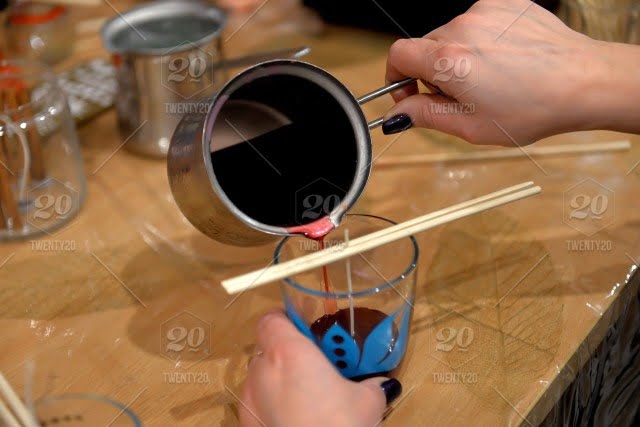Soy wax has rapidly gained popularity in the world of candle making, and for good reason. With its natural composition, clean burn, and sustainability, soy wax is becoming the go-to choice for crafters and candle enthusiasts alike. In this article, we will explore the art of making soy wax candles from scratch, guiding you through each step to create your own personalized masterpieces.
Candles have long been a symbol of comfort, relaxation, and ambience. However, conventional paraffin wax candles often release harmful toxins when burned. Soy wax offers a cleaner alternative that not only benefits our health but also the environment. Made from soybean oil, soy wax is derived from a renewable resource that supports sustainable agriculture practices.
In recent years, the demand for eco-friendly products has fueled the rising popularity of soy wax candles. Manufacturers and individuals alike are realizing the many benefits of using soy wax – not only does it produce less soot and smoke than traditional candles but it also has an exceptional scent throw.
Plus, with its slower burn rate, soy wax candles last longer than their counterparts made with other waxes. So whether you are a candle enthusiast looking to create your own unique scents or someone seeking healthier alternatives for their home decor, learning how to make soy wax candles is a skill worth acquiring.
Understanding the Basics
Soy wax is a type of natural wax that is derived from soybean oil. It is an alternative to traditional paraffin wax, which is derived from petroleum. Soy wax has gained popularity in the candle making industry due to its numerous benefits and environmentally friendly nature.
One of the main advantages of soy wax is its clean burn. When burned, soy wax produces little to no soot, making it a healthier option for both your home and the environment. This clean burn also means that soy wax candles have a longer burning time compared to those made with other types of wax.
Another benefit of using soy wax is its renewable and sustainable nature. Soybeans are a renewable resource, meaning they can be grown and harvested without depleting their source. The production of soy wax also has a lower carbon footprint compared to other waxes, making it an eco-friendly choice for candle makers.
In addition to being environmentally friendly, soy wax offers excellent fragrance retention. It has the ability to hold onto scents well, resulting in candles that release their fragrance evenly throughout their burn time.
Overall, soy wax is an ideal choice for candle making due to its clean burn, sustainability, and fragrance retention properties. Its increasing popularity in the industry reflects consumers’ desire for more eco-friendly alternatives without compromising on quality or performance.
| Advantages | Description |
|---|---|
| Clean Burn | Soy wax produces little to no soot when burned. |
| Renewable & amp; Sustainable | Soybeans are a renewable resource and the production of soy wax has a lower carbon footprint. |
| Fragrance Retention | Soy wax holds onto scents well, resulting in even fragrance release. |
Gathering Your Supplies
Before you begin making soy wax candles, it is important to gather all the necessary supplies and equipment. Having everything ready beforehand will ensure a smooth and efficient candle-making process. Here is a list of essential materials and equipment you will need:
Materials:
- Soy Wax: The main component of soy wax candles. Be sure to choose high-quality soy wax for the best results.
- Fragrance Oils: These oils add scent to your candles and come in a variety of options such as lavender, vanilla, or citrus.
- Candle Dyes: Used to add color to your soy wax. Liquid or solid dyes are available in a wide range of colors.
- Candle Containers: You can use jars or votive holders as containers for your candles. Make sure they are heat-resistant and suitable for candle making.
- Wicks: Choose wicks specifically designed for soy wax candles, ensuring proper burning and minimal soot.
- Wick Stickers or Glue Dots: These adhesive tools help secure the wick to the bottom of the container during pouring.
- Thermometer: A thermometer is essential for monitoring the temperature of the melted soy wax accurately.
Equipment:
- Double Boiler or Melting Pot: Used to melt the soy wax gently without direct heat contact.
- Stirring Utensil: A heat-resistant spoon or spatula for stirring the melted wax, fragrance oils, and dyes evenly.
- Scale: A digital scale is useful for measuring precise amounts of soy wax, fragrance oils, and candle dyes.
- Pouring Pot or Pitcher: This tool makes it easier to pour the melted soy wax into candle containers without spilling.
- Clothespins or Popsicle Sticks: These can be used to hold the wick in place while the candle cools and hardens.
- Safety Equipment: It is crucial to wear heat-resistant gloves and safety goggles to protect yourself from burns and spills.
By having all these essential materials and equipment in place, you will be fully prepared to start making your own soy wax candles.
Preparing the Soy Wax
Once you have gathered all the necessary supplies for making soy wax candles, it’s time to prepare the wax. Properly melting and prepping the soy wax is essential to ensure that your candles turn out beautifully.
The first step in preparing the soy wax is to measure the desired amount of wax flakes. It is important to follow the recommended measurements provided by your specific candle-making recipe or instructions. Using a kitchen scale can help ensure accurate measurements.
Next, you will need to melt the soy wax flakes. The most common method is using a double boiler setup. Fill a large pot with water and place it on the stove over medium heat. Place a smaller pot or heat-resistant container into the larger pot, making sure that it fits securely without touching the bottom of the larger pot. This will create indirect heat that will gently melt the wax.
Add your measured soy wax flakes into the smaller pot or container and allow them to melt slowly. Stir occasionally with a heat-resistant spoon or spatula to promote even melting. Be patient and avoid rushing this process as overheating can affect the quality of your final product.
Once all of the soy wax has melted completely, it’s time to add any desired additives such as fragrance oils or colorants according to your personal preference. Stir well to ensure these additives are thoroughly incorporated into the melted wax.
At this point, you have successfully prepared your melted soy wax for candle making. Before pouring this mixture into candle containers, make sure that they are clean and free from any debris or dust particles that may affect the appearance of your finished candles.
| Items Needed | Instructions |
|---|---|
| Soy Wax Flakes | Measure desired amount using a kitchen scale. |
| Double Boiler Setup | Fill a large pot with water and place a smaller pot or heat-resistant container into it. Melt the wax slowly over medium heat. |
| Additives (fragrance oils, colorants) | Add desired additives to the melted wax and stir well. |
| Clean Candle Containers | Ensure that candle containers are clean before pouring in the melted wax. |
Properly preparing your soy wax is crucial for creating high-quality candles. By following these step-by-step instructions, you will be on your way to making beautifully scented soy wax candles in no time.
Customizing Your Candle
When it comes to making soy wax candles, one of the most exciting aspects is customizing them with fragrance and color. By adding these elements, you can create a truly personalized candle that suits your preferences or matches your home decor. In this section, we will explore different ways to add fragrance and color to your soy wax, providing you with tips and techniques to achieve the desired results.
Adding Fragrance to Your Soy Wax Candles
To add fragrance to your soy wax candles, there are several options available. One popular choice is using fragrance oils specifically designed for candle making. These oils are formulated to mix well with soy wax and provide a strong scent throw when the candle burns. When selecting fragrance oils, consider the type of scent you prefer, whether it’s floral, fruity, or something more unique like vanilla or sandalwood.
Another option to add fragrance is using essential oils. Essential oils offer a natural alternative and come in a wide range of scents, each with its own therapeutic benefits. However, keep in mind that not all essential oils are suitable for candle making as they may have low heat tolerance or cause discoloration. Research the properties of each oil before using them in your soy wax candles.
Coloring Your Soy Wax Candles
Coloring your soy wax candles can be an enjoyable part of the candle making process as it allows you to experiment with different hues and create visually appealing designs. There are various methods for coloring soy wax candles:
- Dye Chips: These are small dye blocks specifically made for candle making. They come in a variety of colors and can be mixed together to create custom shades.
- Liquid Dyes: Liquid dyes offer more control over color intensity as they can easily be added drop by drop until the desired shade is achieved.
- Pigments: Pigments are ideal for achieving vibrant and opaque colors in your soy wax candles. It is important to note that pigments may require thorough blending and careful measuring to avoid clumping or uneven color distribution.
When using any coloring method, it is recommended to start with a small amount and gradually add more until the desired color is achieved. Remember to stir the wax thoroughly after adding the colorant to ensure even distribution.
By customizing your soy wax candles with fragrance and color, you can create unique pieces that not only look beautiful but also fill your space with delightful scents. Experiment with different combinations and techniques to find what works best for you, whether it’s a classic lavender candle or a vibrant blueberry pie scented one. Let your creativity shine through as you enjoy the process of making personalized soy wax candles.
Choosing the Right Wicks
When it comes to making soy wax candles, choosing the right wick is essential for achieving optimal performance and burn quality. A properly chosen wick ensures that the candle burns evenly, releases fragrance effectively, and minimizes smoke or soot production. Here is a guide to help you select the perfect wicks for your soy wax candles:
- Consider the diameter of your candle: One of the most important factors in selecting the right wick is considering the size or diameter of your candle. Wicks are available in various sizes to accommodate different candle diameters. A general rule of thumb is to choose a wick that is slightly smaller than the diameter of your candle. This allows for an even and controlled burn.
- Determine the type of soy wax you’re using: The type of soy wax you use can also influence your choice of wick. Different soy waxes have different melting points and compositions, which can affect how they interact with wicks. It’s important to research or consult with your soy wax supplier to determine which types of wicks work best with the specific soy wax you are using.
- Consider the desired burn time: The burn time of a candle refers to how long it takes for the entire pool of melted wax to reach the edges of the container. If you prefer longer burn times, you’ll want to choose a thicker or larger-sized wick. On the other hand, if you prefer shorter burn times, opt for a thinner or smaller-sized wick.
- Experiment and test: It’s always recommended to conduct some trial-and-error experimentation when selecting wicks for your soy wax candles. Start by testing different types and sizes of wicks on small batches of candles before committing to a particular option. Observe how each wick performs in terms of burn quality, flame height, and soot production.
Remember that choosing the right wick may require some adjustments and fine-tuning based on your specific candle-making process, container size, and personal preferences. Don’t be afraid to explore different options until you find the perfect wick that suits your needs.
Pouring and Setting the Wax
Pouring and setting the wax is a crucial step in the soy wax candle making process. It determines the final appearance and overall quality of your candles. To achieve a smooth and even finish, it is important to follow proper techniques and pay attention to detail. Here are some guidelines to help you pour and set your soy wax candles successfully:
- Prepare your workspace: Before pouring the wax, make sure your workspace is clean, organized, and free from any clutter. Lay down newspaper or a protective surface to catch any spills or drips. This will make it easier to clean up afterwards.
- Use a double boiler method: To melt the soy wax, use a double boiler setup instead of directly heating it on the stovetop. Place a heat-resistant container filled with soy wax in a larger pot filled with water. Heat the water on low to medium heat, allowing the indirect heat to melt the wax gently and evenly.
- Monitor the temperature: It is important to monitor the temperature of the melted soy wax before pouring it into your containers. Ideally, you should aim for a temperature between 120-140 degrees Fahrenheit (49-60 degrees Celsius). Using a thermometer will help you accurately gauge the temperature.
- Add fragrance and color: If you choose to add fragrance or color to your soy wax candles, this is the time to do so. Add them gradually and stir gently until they are well incorporated into the melted wax.
- Slowly pour into containers: When pouring the melted soy wax into your chosen containers, do so slowly and steadily. Start from one side and move towards the other side in a circular motion. This helps prevent air bubbles from forming.
- Allow for proper curing time: After pouring the wax, allow it sufficient time to cool and set properly before moving or touching the candles. The curing time will depend on various factors such as temperature and humidity but generally ranges from 2-4 hours.
By following these techniques, you can ensure that your soy wax candles have a smooth and even finish. Remember to exercise patience throughout the process, as rushing may lead to imperfections in your final product. With practice and attention to detail, you will soon be able to create beautiful, professional-looking soy wax candles that will delight both yourself and your loved ones.
Maintaining and Caring for Your Soy Wax Candles
Properly caring for your soy wax candles is essential to ensure their longevity and maintain their quality. By following a few simple tips, you can maximize the burning time of your candles and enjoy them for many hours to come.
Storage
To preserve the fragrance and integrity of your soy wax candles, it is crucial to store them properly. Keep your candles in a cool, dry place away from direct sunlight and extreme temperatures. Heat can cause the wax to melt or warp, while exposure to sunlight can fade the color and scent of the candle.
If you have multiple candles, consider keeping them in a container or drawer to protect them from dust, dirt, or accidental damage. Additionally, make sure that the lids of any candle containers are tightly closed to prevent dust accumulation.
Trimming the Wick
Before every use, remember to trim the wick of your soy wax candle to about ¼ inch in length. A long wick can create larger flames that burn through the wax quickly and produce more soot. Trimming the wick ensures a cleaner and longer burn.
Use sharp scissors or a wick trimmer specifically designed for candle wicks. Trim the wick gently while avoiding excess pressure that may cause the wick to fall into melted wax. Dispose of any trimmed pieces carefully.
Avoid Drafts
When burning soy wax candles, it’s important to keep them away from drafts such as open windows, fans, or air conditioning vents. Drafts can cause an uneven burn by disrupting the flame’s stability and may result in wasted wax.
An uneven burn not only reduces the lifespan of your candle but also leads to unsightly tunnelling where only a small portion melts while leaving unmelted wax on the sides. To prevent tunnelling, always allow the candle to burn long enough to create an even wax pool across the entire surface before extinguishing it.
Extinguishing the Flame
To extinguish your soy wax candle, use a snuffer or gently blow out the flame. Avoid blowing too hard, as this can cause hot wax to splatter or leave behind soot on the container’s walls. Also, never use water to put out a soy wax candle, as water can cause cracking or breakage in glass containers.
To further prevent any potential hazards, do not move the candle while it is lit or when the wax is still molten. Allow the candle to cool and solidify completely before handling it again.
By applying these simple tips for caring and maintaining your soy wax candles, you can extend their lifespan and enjoy their beautiful glow and aroma for many peaceful moments of relaxation. With proper storage and regular maintenance, your handmade soy wax candles will continue to bring warmth and ambiance to your space.
Troubleshooting Common Issues
Making soy wax candles can be a rewarding and enjoyable experience, but like any craft, it can come with its fair share of challenges. In this section, we will explore some common issues that may arise during the soy wax candle making process and provide practical solutions to help you overcome them.
One common problem that many candle makers encounter is tunneling. Tunneling occurs when the wax burns down the center of the candle, leaving a thick wall of unmelted wax around the edges. To prevent tunneling, it is important to ensure that your candle is properly wicked.
A wick that is too small for the diameter of your container can lead to poor heat distribution and cause tunneling. Consider using a wick size chart or seeking guidance from experienced candle makers to select the appropriate wick for your specific container and wax type.
Another issue that may arise is frosting on your finished candles. Frosting appears as a white, hazy layer on the surface of the wax and can detract from the overall appearance of your candles. Frosting is a natural characteristic of soy wax and occurs when the wax cools too quickly or experiences temperature fluctuations while setting.
To minimize frosting, try placing your candles in a warm water bath after pouring to allow for gradual cooling. You can also experiment with different pouring temperatures or add an additive such as stearic acid to reduce frosting.
Scent throw is another concern that candle makers often face. Scent throw refers to how well the fragrance disperses into the air when the candle is burned. If you find that your soy wax candles are not emitting enough scent, there could be a few factors at play.
Make sure you are using high-quality fragrance oils designed specifically for candle making and following recommended usage rates. Additionally, consider increasing the concentration of fragrance oil in your recipe or trying different scent combinations to find the right balance for your preferences.
By being aware of these common issues and learning how to troubleshoot them, you can overcome challenges that may arise during the soy wax candle making process. Remember that practice makes perfect, and don’t be discouraged if you encounter setbacks along the way. With time, patience, and a bit of problem-solving, you will be able to create beautiful and fragrant soy wax candles that bring warmth and ambiance to any space.
Conclusion
In conclusion, soy wax candle making is a rapidly growing trend that allows individuals to unleash their creativity and produce high-quality, personalized candles. With its numerous benefits such as being eco-friendly, clean-burning, and biodegradable, soy wax has become the go-to choice for many candle enthusiasts. By understanding the basics of soy wax and gathering the necessary supplies and equipment, anyone can embark on their own candle making journey.
One of the most exciting aspects of soy wax candle making is the ability to customize your candles. Whether you want to add fragrance or color to create a specific ambiance or simply enhance the aesthetic appeal of your candles, there are endless possibilities for personalization. The guide provided in this article offers step-by-step instructions for melting and prepping the soy wax, as well as selecting the perfect wicks for optimal burn time.
Once you have mastered the art of pouring and setting the wax, it is important to know how to care for your soy wax candles properly. Proper storage and maintenance can significantly extend their lifespan and ensure that you get maximum enjoyment out of each one. Lastly, if you encounter any challenges along the way, refer to our troubleshooting section for solutions.
So why wait? Embrace the art of soy wax candle making today. With its many advantages and the satisfaction of creating your own unique masterpieces, this craft is not only a fulfilling hobby but also an opportunity to explore your creativity. Start gathering your supplies and following these instructions – before you know it, you’ll have a collection of beautiful handmade candles that will light up any space with warmth and elegance.
Frequently Asked Questions
How do you make soy wax?
Soy wax is made from hydrogenated soybean oil, which is derived from soybeans. The process of making soy wax begins with gathering the soybeans and cleaning them thoroughly to remove any impurities. Then, the beans are heated and crushed to extract the oil.
This oil is then purified and undergoes a process called hydrogenation, where hydrogen atoms are added to convert the unsaturated fats into saturated fats. Finally, the resulting substance is cooled and solidified into flakes or pellets, which can be melted down to make candles.
What are the ingredients in soy wax candles?
The ingredients in soy wax candles primarily include soy wax as the base material. However, additional components may be added for fragrance, color, and stability. Fragrances can be in the form of essential oils or synthetic fragrances specifically designed for candle-making.
Colorants can be liquid dyes or sometimes natural additives like dried flowers or herbs for an organic look. To enhance stability and ensure proper burning, some candle makers may also incorporate additives such as stearic acid or beeswax blends into their soy wax candles.
How do you make wax for candles?
Making wax for candles involves different techniques depending on the type of wax being used. For traditional paraffin wax candles, a commonly used method includes melting solid paraffin wax in a double boiler or a dedicated melting pot over low heat until it reaches a liquid state.
The liquid wax is then poured into containers while inserting pre-tabbed wicks at the center. As it cools and solidifies, the wick becomes embedded in the hardened wax.

Welcome to my candle making blog! In this blog, I will be sharing my tips and tricks for making candles. I will also be sharing some of my favorite recipes.





